Richard Hudnut (post 1945)
Continued from: Richard Hudnut (1920-1945)
By 1945, Gustave A. Pfeiffer [1872-1953] was the only remaining member of the original Pfeiffer company that had invested in William R. Warner in 1908 and bought Richard Hudnut in 1916. The businesses needed revitalising but Pfeiffer, who was now in his seventies and did not feel up to the task, approached Elmer H. Bobst to take on the role. Bobst had recently retired from the Swiss company, Hoffman-LaRoche where he had restructured its American subsidiary, Roche-Nutley, into a highly profitable concern. It had also made him one of America’s highest paid executives and a very wealthily man.
The agreement Bobst struck with G. A. Pfeiffer allowed him to buy 11% of the common stock of William R. Warner and he became Warner’s president and chief executive officer in 1945. After completing a review of the businesses, he began a series of reforms and restructures.
Warner-Hudnut
In 1950, Bobst combined William R. Warner and Richard Hudnut into a new corporation, Warner-Hudnut, Inc., and realigned its component parts into four separate divisions: William R. Warner, pharmaceuticals; Richard Hudnut, cosmetics; Standard Laboratories, proprietary medicines and toiletries; and the Foreign Division which handled the products of the other divisions in 18 foreign countries. Stock in the company was then offered for sale.
The 1950 prospectus, released before the sale of the stock, revealed that cosmetics accounted for most of the company’s sales, but were barely turning a profit. In addition, it was hair-care, not skin-care or make-up, that generated the most volumes (Drug & Cosmetic Industry, 1951).
The Pfeiffer family businesses had grown largely through acquisitions and Bobst continued this tradition by acquiring number of new businesses. Some of these were to correct deficiencies in Hudnut’s cosmetics and toiletries range. These purchases included: Courtley, a range of men’s toiletries (1946); Raymond Laboratories, which manufactured permanent waving solutions (1946); and Chen Yu, a popular brand of nail polish (1948). The company also strengthened its perfume range when it bought the New York branch of Ciro, Inc.
Courtley
Although some products had been developed by Richard Hudnut that could be used by men, and some were produced specifically for them, this company weakness became more of a problem after many American men had gotten use to grooming products during the Second World War.
Courtley, Inc., a company with one of the largest selling men’s lines in the United States at the time gave Warner-Hudnut a men’s range that included colognes, shaving soaps, face lotions and talcs. However, the merger with Lambert Pharmacal came with a second men’s line, Sportsman, and this led to Warner-Lambert selling the Courtley line to Lee Ltd. in 1955.
Chen Yu
Nail polish had become more important in the 1930s, particularly after Revlon began making matching lipsticks from 1939. A liquid nail polish had been a part of Richard Hudnut’s cosmetic lines for decades but it was not a strong seller. In December, 1948, the Chen Yu range of lipsticks and nail polishes was purchased. Warner-Hudnut had abandoned the brand in the United States by 1955 but it remained an important outlet for Hudnut products in Europe where it grew into a full cosmetics line.
See also: Chen Yu
Other purchases strengthened Warner-Hudnut’s pharmaceutical business. In 1952, Chilcott Laboratories was acquired in a US$4.5 million stock-swap deal. The purchase also allowed Bobst to begin refreshing the company’s ailing infrastructure. Land was secured next to Chilott’s factory in Morris Plains, New Jersey and an additional plant was built there, adding a research facility in 1956. This would become the main headquarters for the company even after its merger with Lambert Pharmacal.
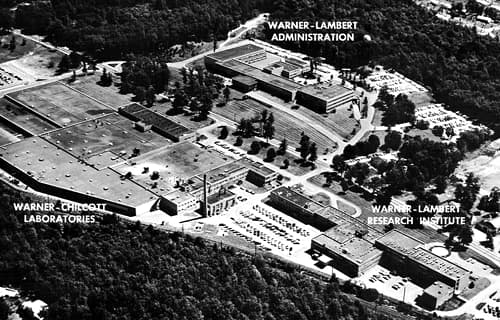
Above: 1967 Warner-Lambert facilities at Morris Plains, New Jersey.
Warner-Lambert
When Gustave A. Pfeiffer died in 1953 his stock in Warner-Hudnut was put on the market. The Wall Street financiers André Meyer [1898-1979] and Ferdinand Eberstadt [1890-1969] organised a syndicate – American Drug Products Ltd. – and bought the shares giving them some 45% of Warner-Hudnut in 1954. They then pressured the company management to acquire other businesses so that the stock price would be pushed up (Smith, 2010, p. 70).
In 1955, Warner-Hudnut merged with Lambert Pharmacal – the makers of Listerine, Pro-phy-lac-tic toothbrushes, and Sportsman toiletries – with the combined operations becoming the Warner-Lambert Pharmaceutical Company. Bobst became the Chairman of the Board of Directors, James Clement Chilcott [1898-1980], of Chilcott Industries, vice chairman, Edward T. T. Williams [c.1879-1968] chairman of the executive committee, and Alfred E. Driscoll [1902-1975] company president. Soon after the merger, Meyer and Eberstadt sold most of their shares at a handsome profit leaving them with about 11% of Warner-Lambert.
After 1955, Warner-Lambert engaged in a series of mergers and acquisitions starting with The Emerson Drug Company of Baltimore, the makers of Bromo-Seltzer antacid, and the Nepera Chemical Company of New York in 1956. Others followed, including American Chicle (1962), Smith Brothers (1964), Texas Pharmacal (1966), American Optical (1967), Vismara Terapeuticai (1967), and Elizabeth Biochemical (1969). These mergers and acquisitions widened the Warner-Lambert’s product base but reduced its interest in cosmetics and toiletries. By 1961, cosmetics only accounted for 16.0% of the company’s world-wide sales (Warner-Lambert annual report, 1961) down from 24.3% in 1955.
The company also began modernising its production facilities. In 1956, a new factory was built in Lititz, Lancaster County, Pennsylvania, initially to manufacture Listerine, the production of Du Barry and Richard Hudnut products was moved there later, allowing the company to sell is ageing properties in West 18th Street, New York.
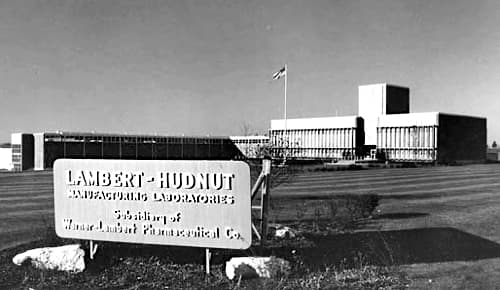
Above: The Lambert-Hudnut plant in Lititz used to manufacture Listerine, Du Barry and Richard Hudnut products.
Cosmetics
When interviewed for a TIME article in 1952, Bobst expressed a low opinion of the chemists who were working at Richard Hudnut when he took over the business.
The business was dominated by cosmetic cooks. They built their products on the basis of sight, smell and feel. They had no regard for the needs of the skin and hair.
(“Corporations: Life begins at 60,” 1952).
To improve this situation, Bobst hired Raymond E. Reed [1908-1990] as the Director of Cosmetic Research and Development for the cosmetic companies controlled by Warner in 1947 and the Hudnut product lines were rationalised. Between 1945 and 1950, the new management worked to discontinue the Three Flowers, Gemey and Marvelous lines in the United States leaving only Du Barry remaining. Some individual items from these abandoned lines survived the cut; e.g., Three Flowers and Gemey fragrances continued to be sold and the company maintained production of Three Flowers Brilliantine due to good sales. Although discontinued in the United States, the Three Flowers and Gemey ranges continued in Europe and other places where Du Barry was not available, such as Australasia and New Zealand. There, Gemey was considered more upmarket than Three Flowers and was generally promoted as French.
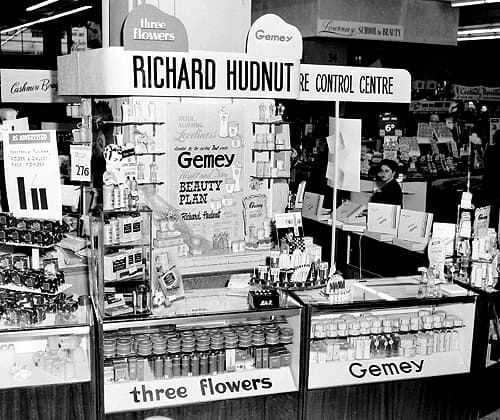
Above: 1953 Myers Department Store counter for Richard Hudnut, Gemey and Three Flowers (Australia).
As mentioned earlier, hair-care rather than skin-care or make-up was generating most of the company’s cosmetics sales. In America, Warner-Lambert’s Family Products Division separated Richard Hudnut hair-care products from the Du Barry range. Then, after the Fifth Avenue salon was shut down in 1955, the Du Barry range was advertised as separate to Richard Hudnut. The split was not clear cut. Most hair-care products were badged as Richard Hudnut but some were still sold under the Du Barry banner. In addition, a few Du Barry products also picked up the Richard Hudnut label. For example, Du Barry Pink Suds (1954) skin cleanser was marked as a Richard Hudnut product in company advertising as was Cool Glow (1960), and Lasting Beauty Makeup Finish (1969).
Du Barry
New products were added to the Du Barry range between 1945 and 1950. The entire line was also repackaged. Starting in 1948 this was largely complete by 1949.
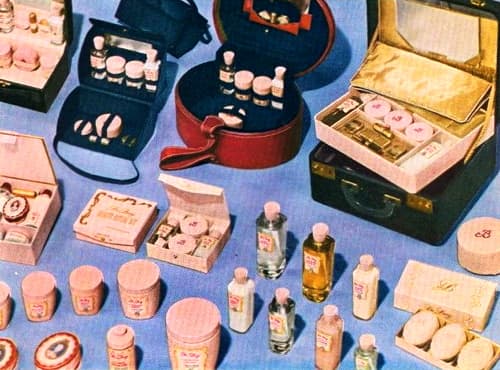
Above: 1950 Du Barry cosmetics in new packaging. Jars are in pink, bottles are square with rounded corners. The face powder is still in oval box but is a soft pink with magenta scallops with the Du Barry portrait retained.
The new management also passed a critical eye over the Success School and Success Course and came to the conclusion that both were unprofitable, shutting them down in 1952. Ann Delafield [b.1880], who managed these courses, left Richard Hudnut and moved on to Rexall.
See also: Ann Delafield
When the Richard Hudnut Du Barry salon on Fifth Avenue closed in 1955 the company also lost its showroom to display products for domestic and foreign buyers. This situation was rectified in 1956 with the opening of a new facility in the Metropolitan Club on the corner of Fifth Avenue and 60th Street, New York.
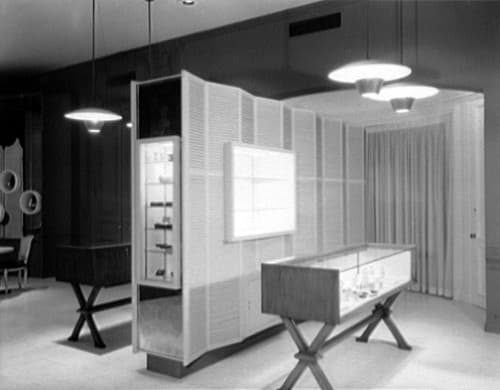
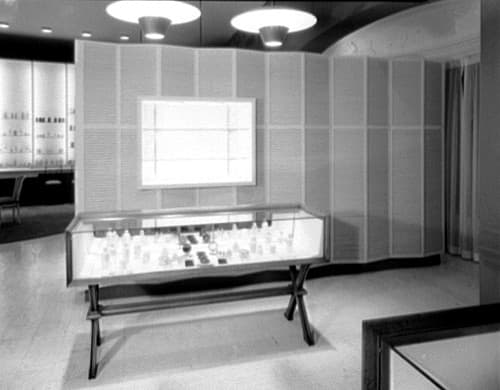
Above: 1956 Two views of the new Du Barry showroom.
Skin-care
Bobst put a top chemist in charge of cosmetics research in 1945 to bring the, as he put it, ‘cosmetic cooks’ into line. The company then began developing new Du Barry skin-care cosmetics based on a series of additives many of which were pseudo-scientific. Starting with vitamins and hormones this progressed to more novel ingredients such as royal jelly, placental extracts and enzymes. George J. Abrams [1918-1978], who left Revlon to join Warner-Hudnut in 1959, spoke enthusiastically about these quasi-scientific cosmetics, branding them as ‘charmaceuticals’s in 1960 (Woodhead, 2003, p. 377).
Vitamins and hormones
The company released two creams containing vitamins A, D, and E: — Du Barry Crème Superbe (1950) a general skin cream; and Liquid Treasure (1954) a day and night treatment cream.
Crème Superbe: “Contains Vitamins A, D, and E, plus smoothing emollients and tocopherol (a special ingredient that tones and revives the skin’s dewy radiance).
Liquid Treasure: “Non-greasy blend of light emollients plus Vitamins A, D, and E. A moisture balm, it supplies and retains essential moisture in the skin.”
A lotion version of Crème Superb, made with silicones, allantoin, humectants, cholesterol and emollient oils, was added in 1956.
Lotion Superbe: “The instant you use rich and creamy, completely non-alkaline Lotion Superbe you’ll see its restorative action in your softer smoother, lovelier hands . . . in your soothed, younger-looking skin. Not a bit greasy. Never sticky. Just creamy-rich and luscious.”
See also: Vitamin Creams
Vitamins were also added to Du Barry’s only hormone cream, Du Barry Penetrating Balm (1953) containing hormones, vitamins and lanolin.
Penetrating Balm: “This fabulous beauty treatment is a magical blend and balance of vitamins, hormones and lanolin that works wonders under, through and on the skin to give it the moist, full look of youth.”
See also: Hormone Creams, Oils and Serums
Du Barry Penetrating Balm was followed by Du Barry Penetrating Cleanser (1958), the later containing ‘Vibranol’. The identity of this trade-named ingredient is unknown to me but it may have been an acetylated lanolin alcohol. Its ‘penetrating power’ was said to help the cleanser remove make-up faster, even indelible lipstick and mascara.
Penetrating Cleanser: “Wonderful lotion cleanser cleans deep, makes skin smooth in seconds! Contains Vibranol, a highly penetrating ingredient that dissolves and floats away old make-up, dust, indelible lipstick, eye shadow. For all skin-types . . . lanolin enriched. Plastic squeeze bottle.”
Royal Jelly
In 1955, Du Barry began its Royal Treatment line containing royal jelly extracted from bees, a fad started in France by French companies like Orlane. Beginning with Royal Treatment Cream (1955), Du Barry followed this with Royal Nectar (1957); and Royal Balm, Royal Eye Crème, Royal Velvet Fluid Make-up, and Royal Lipstick (1958)
Royal Treatment Cream: “Now, her precious beauty secret is yours in this luxurious queen of creams…to soften and make supple dry or mature skin…to prevent and smooth away fine surface lines.”
Royal Nectar: “24-hour beauty treatment for dry and thirsting skin. Gives deep moisture benefits, all day under make-up and at night. Wonderful way to combat dryness, lines, signs of age. Contains humectants, Vitamins A, D, E, rich emollients, Royal Jelly benefits.”
Royal Balm: “Skin beautifier with Royal Jelly. Smooths, pampers hands roughened and dried by soaps, detergents, exposure. Luxuriously creamy, non-greasy, non-sticky. Penetrates deep into hidden layers of the skin.”
Royal Eye Crème: “[R]ich with proteins, vitamins, penetrating moisturizers and emollients will pamper and protect your skin from those age-signs and expression lines.”
Royal Velvet Fluid Make-up: “An exquisitely light flowing foundation that seems to make lines, shadows and tiny imperfections disappear instantly.’
A number of Royal Treatment hair-care products were also added in 1958 including Royal Shampoo, Royal Creme Rinse, and Royal Hair Conditioner.
See also: Royal Jelly and the company booklet Du Barry’s Royal Family (1959)
Placental Extracts
Du Barry skin-care products containing placental extract started with Du Barry Elixir Natale, Creme Natale and Moisture Petals, the later being the company’s first moisturiser, all released in 1958. Some of these products also contained vitamins and enzymes as did Du Barry Penetrating Cleanser with enzymes, also introduced in 1958. By the following year all of these skin-care cosmetics were also being described as hypoallergenic, a marketing strategy the company employed well before it acquired Texas Pharmacal, the makers of the Allercreme range of hypoallergenic skin-care and make-up products.
Creme Natale: “Rich night cream with Placentine, for mature skin, in a formula that permits deep penetration of cellular life elements. Contains vitamins, enzymes, esters that help sustain cellular life. Unmatched for effectiveness against lines, wrinkles and aging skin.”
Elixir Natale: “Revolutionary, smooths out tiny lines, wrinkles helps banish the faded look of age.”
Moisture Petals: “A new kind of greaseless deep-moisturizing foundation. Whether your skin is dry, oily or normal, if you’re over 25, Moisture Petals is your underlying secret of a smooth, fresh young look—a fresh, dewy, long-lasting make-up.”
Penetrating Cleanser: “Pore-deep cleansing lotion with enzymes—most efficient organic skin cleansers known, to remove clogging soil and oil. Spreads quickly, penetrates deeply, tissues off easily.”
See also: Placental Creams and Serums
The exaggerated claims made for Creme Natale and Elixir Natale got the company into trouble with the Federal Trade Commission (FTC) following the passing of the Food, Drug and Cosmetic Act (FD&CA) of 1938. This forced them to scale back on many of their claims for the product and may have led to the introduction of Du Barry Crème Paradox in 1960.
Paradox
Du Barry Crème Paradox (1960) was a beauty-sleep cream with N.O.R. (Natural Oil Replacement). Containing polyunsaturated oils, Placentine (a placental extract) and panthenol, but not lanolin or hormones, Paradox was marketed as being a close match to the natural oils of the skin. Given that George J. Abrams had joined Warner-Lambert in 1959, the cream may have been a response to Revlon’s Ultima (1959). Like Ultima, Crème Paradox was introduced in an upmarket container to separate it from other products in the Du Barry line.
Crème Paradox: “Delicate as gossamer, rapidly absorbed. Works deep down to bring silken smoothness to dry, lined, flaky skin. No sticky film. All you can see and feel is dewy, young-complexion charm!”
Following the introduction of Crème Paradox, Du Barry added other items to create a small Paradox range which included: Paradox Creme Cleanser, and Paradox Moisturizing Lotion (1963); and Paradox Milk Bath, Paradox Body Crème, and Paradox After-Bath Dusting Powder (1965).
Other additives
These included alginates extracted from seaweed as well as silicones, allantoin, lanolin, polyunsaturates and enzymes. These ingredients were used in skin-care cosmetics such as cleansers, face masks and night creams, Young Promise (1956) and Dory Beauty Masque (1960) being good examples.
Young Promise: “Polyunsaturate cream. A dry skin emollient to help skin regain its soft, unlined look. Contains newly discovered Polyunsaturates for deeper, better penetration.”
Dory Beauty Masque: “[C]ontaining alginate derived from marine algae. Like no other beauty mask! Acclaimed as the greatest cleansing and firming cosmetic ever devised Immediate results.”
The Dory Beauty Mask was Du Barry’ second firming mask, it followed Vibrance Creme Masque (1957).
Vibrance Creme Masque: “Just smooth on Vibrance, tissue off, and there you are . . . skin refreshed with the Du Barry vibrant look! Vibrance never hardens like old-fashioned masks. It stays creamy for the good of your skin.”
Treatment regimes
Du Barry continued with the four-step routine it used before the war ‘ Cleanse, Lubricate, Firm and Protect – through to the early 1950s. However, this treatment routine was built around the ‘Beauty Angle’ used in the Du Barry Success School, the Du Barry Success Course and the Richard Hudnut Du Barry Salon on Fifth Avenue. Their closure necessitated alterations to the routine above and beyond the incorporation of new products.
By 1955, the overall four-step routine had changed from Cleanse, Lubricate, Firm and Protect to Cleanse, Freshen, Lubricate and Tone but this did not always apply.
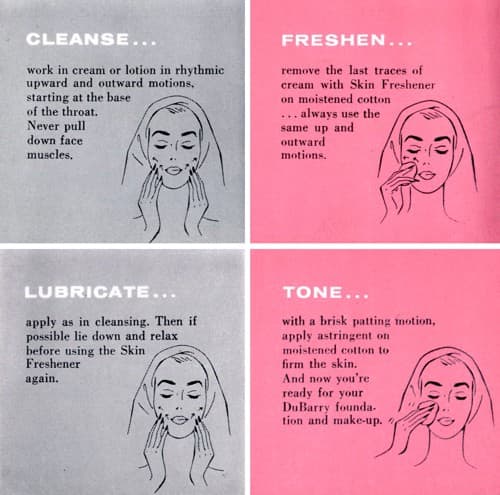
Above: 1955 Four quick steps. The suggestion that you lie down and relax before using the Skin Freshener a second time may be a hangover from the earlier practice of the Beauty Angle.
Morning and evening routines were also added to the various skin types including one for teen-age skin that largely repeated the treatment routine for oily skin. The dry skin routine is given below:
AND SO TO BED
Cleanse with Cleansing Cream for Dry skin or Penetrating Cleanser
Freshen with Skin Freshener
Lubricate with Creme Superbe
For eye wrinkles (and expression lines) Eye Cream
For special throat care Derma-Sec Formula.MORNING WAKE-UP
Cleanse with Cleansing Cream for Dry skin or Penetrating Cleanser
Freshen with Skin Freshener
Tone with Skin Forming Lotion
Protect with Foundation Lotion(Modified from Richard Hudnut, 1955, pp, 6-7)
Make-up
The development of new forms of make-up that started with Max Factor’s Pan-Cake (1937) and then continued with new formulations for cream, pressed cream, stick and liquid foundations, required Richard Hudnut to update its make-up lines to keep pace with these new trends.
Foundations and powders
In the 1940s, Du Barry added Sophisti-Cake (1947) and Sophisti-Creme (1949) to its long-standing Du Barry Foundation Lotion. Sophisti-Cake was a pancake-type make-up similar to Max Factor’s Pancake. By 1955, both forms of make-up were available in Cream Beige, Petal Pink, Champagne Beige, Rose Beige, Blush Tan, Tropical, and Morocco shades.
Sophisti-Cake: “The unique powder-cake that’s non-drying. Day and night glamour for every type of skin. Achieves a flawless mat-finish that camouflages little imperfections. Blends easily with moist cotton or sponge.”
Sophisti-Creme: “A luxurious color cream-cake in a handy-to-carry case. Smooths on like satin, covers tiny flaws, gives your skin a young radiance. Keeps powder clinging for hours. Requires no water.” Shades: Cream Beige, Rose Beige, Champagne Beige, Blush Tan, Morocco, and Tropical with Petal Pink added in 1951.
In the 1950s, Du Barry added a range of ‘flatter’ products starting with Flatter-Face (1952) a powder-cream compact with mirror and washable nylon puff. This was followed by Flatter-Glo (1953), a liquid foundation with a matt-finish, and Flatter Fluff (1959), a cream foundation. Shade ranges were limited.
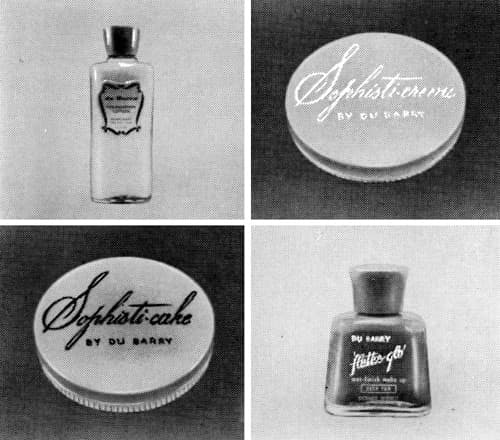
Above: 1955 Du Barry Foundation Lotion, Sophisti-Creme, Sophisti-Cake and Flatter Glo.
Flatter-Face: “The powder-plus-foundation in one! Lovely, quick way to achieve a poreless, petal-smooth complexion …and it clings for hours.” Shades: Champagne Beige, Rose Beige, Tropical, and Blush Tan, with Truly Pink, Morocco, and Deep Tan available by 1955.
Flatter-Glo: “Whisper light, it glides on quickly, easily, stays fresh for hours. Pores and tiny flaws seem to disappear.” Shades: Cream Beige, Champagne Beige, Rose Beige, Petal Pink, and Tropical, with Fair (1954), and Truly Pink, and Deep Tan (1955) added later.
Flatter Fluff: “Fabulous feather-fine make-up that brings flawless color, silken radiance to drab skin instantly. Creamy fluff, so light, its dewy glow seems part of you! Flatters tired lines, shadows, out of sight. Your complexion looks fresh, poreless. Luminous! Lovely!” Shades: Truly Pink, Natural (untinted), Champagne Beige, Rose Beige, Rose Blush, Tropical, and Deep Tan.
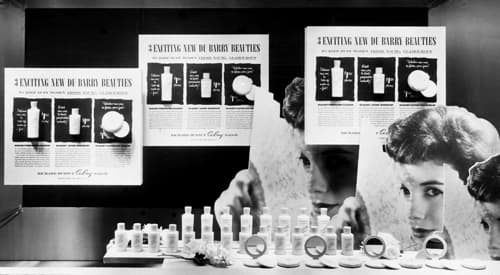
Above: c.1952 Window display of ‘Exciting New Du Barry Beauties’. The products on display are bottles of Du Barry Lotion Deodorant (1952) along with Du Barry Flatter-Face compacts (1952). Du Barry Drystick cream deodorant and anti-perspirant was added in 1953.
It is worth noting that ‘flatter’ was first used in the Chen Yu range – acquired by Warner-Hudnut in 1948 – to name the Flatter Box (1950) which contained Chen Yu Fluid Cloud Silk, a creamy liquid foundation, Chen Yu Cloud Silk Compressed Powder with matt finish, and a Chen Yu Lipstick.
Du Barry only had a single face power until the late 1950s. By 1955, this was available in Rachel #1, Rachel #2, Cream Beige, Special Rachel, Naturelle, Fair, Petal Pink, Champagne Beige, Rose Beige, Blush Tan, Tropical, and Morocco shades. In 1958, Du Barry added Cloudsilk Pearled Face Powder. As already noted, a Cloud Silk had been previously appeared as a Chen Yu product but, as Warner-Lambert had abandoned the Chen Yu range in the United States by 1955, the name was going spare. The Du Barry version came in two forms: loose in powder boxes and compressed in gold-trimmed, simulated tortoise shell compacts, complete with puff and mirror. Both were said to contain real pearl powder and royal jelly, and were to be applied over Royal Velvet Fluid Make-up (1957), a member of the Royal Treatment Range which came in six shades. Cloudsilk Pearled Face Powder was luminous rather than matt, as was the case with the pre-existing Du Barry Face Powder. The pearlescent look could be extended to the lips by applying a White Shimmer Lipstick (1959) over another lipstick colour.
Cloudsilk Pearled Face Powder: “A whole new experience in beauty awaits you with DuBarry’s fantastically fine-spun, fragrant face powder. It actually glows with powdered pearls . . . and it contains Royal Jelly of the Queen Bee! Veils tiny shadows with a loveliness that’s luminous. Gives your skin a smooth, silken finish that’s sheer perfection!” Shades: Truly Pink, Rose Blush, Champagne Beige, Rose Beige, Morocco, and Tropical.
Royal Velvet Fluid Make-up: “So fair and flattering for hours . . . while it softens, smooths and helps erase tiny tell-tale age-signs!”
Lipsticks
At the end of the Second World War, Du Barry lipsticks came in eight shades: Rose Cerise, Red Violet, Regal Red, Black Cherry, Carmeen, Emblem Red, Crimson, and Red Gold. A number of new colours were added through to 1950 including: Strawberry, and Clarion (1945); Primitive Red (1946); American Beauty, Scarlet Rose, and Pink Promise (1947); Petal Pink (1948); Rose Geranium, and Radiant Red (1949); and Snow Ball of Fire (1950).
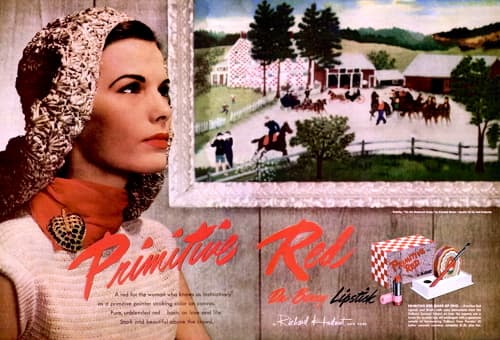
Above: 1946 Du Barry Primitive Red.
Du Barry Lipsticks manufactured in 1945 or early 1946, such as Clarion and Primitive Red, were still packed in cases with plastic caps but all-metal caplok cases arrived late in 1946 when metal became available once more.
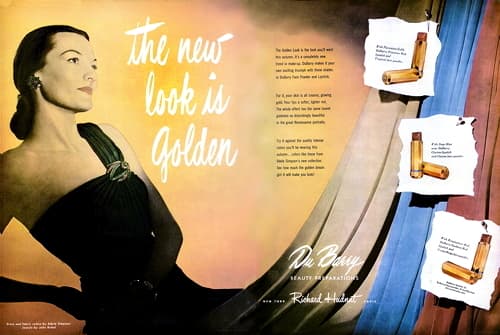
Above: 1946 Du Barry Golden Look. Clarion Lipstick with Clarion Powder, Emblem Red Lipstick with Cream Beige Powder, and Primitive Red Lipstick with Tropical Face Powder. All the lipsticks are now packaged in metal, gilt-tone caplok cases.
In 1947, Du Barry added Treasure Stick lipstick in a new case that had a clear, lucite base and a gilt-tone cap. The ‘wonder formula’ indelible lipstick in Treasure Stick came in twelve shades, three of which were new – American Beauty, Scarlet Rose, and Pink Promise.
Treasure Stick: “It smooths on your lips with satin radiance. And then it’s here to stay . . . constant, non-drying lip beauty you won’t easily eat off, drink off smear off on glass or silver. Not one, but two of the finest emollients obtainable are blended in to give doubly soft protection. Yet the texture is so firm you can get a line as clear-cut as with a brush.”
This new Du Barry Lipstick was said to not “easily eat off, drink off or smear off” or “eat off, drink off or kiss off”. These advertising catchlines debuted well before Hazel Bishop introduced her Lasting Lipstick (1951) – that “won’t eat off, bite off, kiss off”.
The arrival of Hazel Bishop’s Lasting Lipstick set off what are known as the American ‘Lipstick Wars’ which lasted right through the 1950s with Hazel Bishop, Revlon and Coty the principal protagonists. The development of Du Barry lipsticks in this period were affected by this struggle and Du Barry also played a small part in the ‘wars’ right at their very end.
Also see: Lipstick Wars
Du Barry Treasure Stick was an indelible but the renewed interest in indelibles created by the success of Hazel Bishop’s Lasting Lipstick seems have triggered the introduction of Du Barry Color-Lasting Lipstick (1952) which had its indelibility built into its name. It came in a choice of caplok or lucite-base cases.
Color-Lasting Lipstick: “Exclusive no-fade, non-smear formula is lanolin rich. Does not irritate or dry your lips. Your mouth stays moist-looking, smooth, inviting for hours longer. And there’s no color change when you blot. The color you apply is the color that remains.” Shades: Red Flare, Radiant Red, Carmeen, Red Gold, Petal Pink, Rose Geranium, Blonde Dubonnet, American Beauty, Scarlet Rose, Regal Rose, Red Triumph, and Red Maple, with Truly Red (1952), Truly Pink (1953), Peachy Pink (1954) and Enchanted Violet added later.
In November, 1955, the company then added Color Glide, another indelible in four shades. Unlike the earlier Du Barry indelibles this one was said to eliminate the need to blot the lips with tissues after the lipstick was applied. Its promotion may have been affected by the arrival of the Coty ‘24’ lipstick earlier in the year. Advertising for Color Glide used similar phrases to Coty’s “Wake up beautiful with ‘alive’ color glowing on your lips!” campaign.
Color Glide Lipstick: “Simply sensational! DuBarry’s new lipstick literally named itself! It just GLIDES on . . . smoothly, effortlessly sheathes your lips in brilliant, lasting color! Stays on ’sround the clock too . . . wake up with glowing color on your lips! No blotting needed with Color Glide . . . just once over lightly and the color ‘sets’naturally. Looks and feels so smooth you'll scarcely know you're wearing it! Shades: Whistle Red, Rosy Promise, Saucy Glow, and Peppermint Pink.
In 1957, Du Barry released Lustre-Life Lipstick. This followed the late 1950s trend in the United States towards creamier lipsticks and may have been modelled on Revlon’s Lustrous Lipstick (1956).
Lustre-Life Lipstick: “This lipstick glides on to stay . . . moistens and creams as it colors.” Shades: Peachy Pink, Enchanted Violet, Pink Fire, Red Flare, Rose Geranium, Truly Red, Petal Pink, Light-Up Red, American Beauty, and Radiant Red, with Truly Orange, and Cool Coral added in 1958.
The Lustre-Life lipstick also appears to have copied Revlon in another way. It debuted in Show Case cases which look to be downmarket copies of Revlon’s Futurama (1955). Warner-Lambert even used the term ‘Beautyrama’ in a number of Show Case advertisements, a name that clearly echoed Futurama. Like Futurama, Show Case also used click-in refills, with a choice of Lustre-Life or Regular ‘Moisturized’ lipsticks.
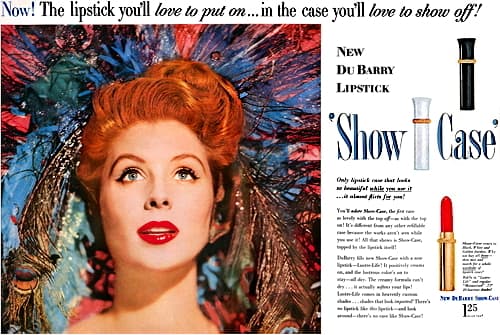
Above: 1957 Du Barry Show Case in Black, White, and Golden finishes.
In 1958, Du Barry added its fourth new lipstick for the decade, the previously mention Royal Lipstick containing royal jelly. It came in yet another a new container, sometimes referred to as the wedding-ring case due to its central gilt band. A second, shimmering-pearlescent, wedding-ring case called Precious Opal was available by 1962. Other variations followed when the lipsticks were packaged in sets that included a matching compact.
Royal Lipstick: “Fabulously rich formula soothes and pampers your lips every minute it’s on! Your lips feel moistened, softened, nourished because the rich rare beauty benefits of Royal Jelly are blended into this new kind of lipstick.” Shades: Pink Parfait, Pink Fire, Cool Coral, Wild Lilac, Warm Poppy, Hot Orange, Truly Red, and Radiant Red.
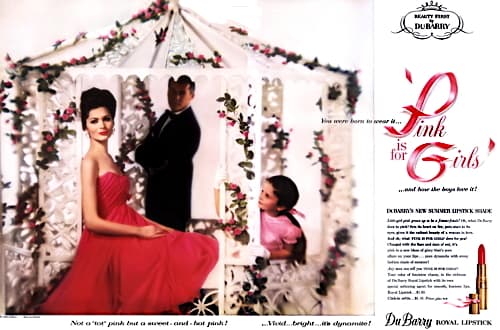
Above: 1960 Du Barry Pink is for Girls.
Additional Royal Lipstick shades included: The Missing Pink (1958); Snow Ball of Fire, a range of pastels – Creme of Roses, Creme of Lilacs, Creme of Peaches, and Creme of Apricots – and White Shimmer, a luminous over-glaze (1959); Pink is for Girls (1960); Flaming Sherbet (1961); Tabasco Red, Raining Rubies, Half Past Pink, and Quarter to Red (1962); Truly Orange (1963); pearlescent overglazes – Pearl Glace, Gold Glace, and Tawny Glace (1964); Spiced Peach, and Love Apple (1965), and Spiced Apple, and Allspice (1966).
In 1959, Du Barry released Lip Quick, a roll-on lipstick developed by the Omega Manufacturing Corporation of Inglewood, California, which gave Revlon a scare at the end of the Lipstick Wars. Packaged in a case that was reminiscent of Show Case, Lip Quick sold well at first but the mechanism soon gummed up, sales plummeted, and did not return even after the problem was rectified.
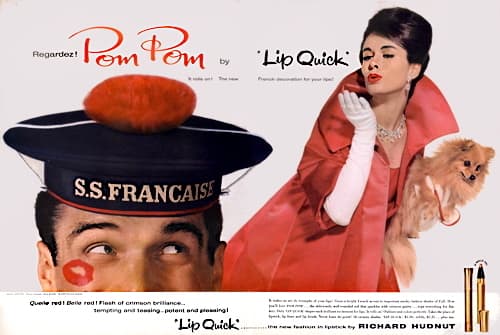
Above: 1960 Lip Quick Pom Pom.
Lip Quick: “[I]n a slim golden case, rolls on flowing color automatically. It outlines, shapes and colors lips, perfectly, cleanly, quickly. Flowing color is stored inside the case, released only as the rounded tip is pressed gently against lips. ‘Lip Quick’ is grease-less—can’t smudge or smear. Easy to apply. Stays on beautifully.” Shades: Bright Poppy, Coolest Coral, Pink Breeze, Red Flare, Heat Lightning, Lazy Pink, Orange Creme, and Cherry Spice.
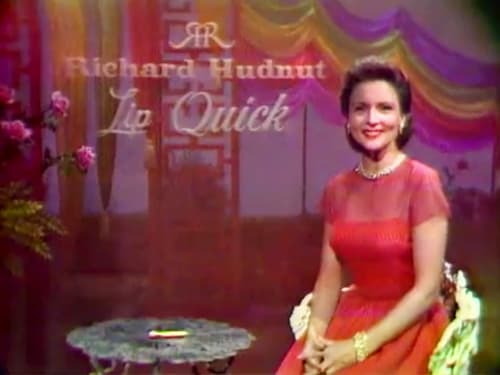
Above: 1959 Betty White [1922-2021] promoting Lip Quick.
Similar products had been tried just after the Second World War and had also failed.
Rouge
As new shades of lipstick were introduced, many were matched with cream and/or compressed powder rouges. By 1955, available shades included Pink Red #1, Pink Red #2, Blue Red #1, Blue Red #2, True Red #1, and True Red #2. One variation from this was Du Barry Bloom (1954) a cream rouge, applied with the fingers that only came in one shade said to go with any complexion. A liquid version was added in 1955.
Bloom: “One shade blends beautifully with every skin tone—and all make-up shades. So simple . . . so quick to apply . . . just a tiny bit smooths on evenly, naturally. You just can’t go wrong with Bloom!”
In 1966, Du Barry added Bloom Dust-On a cake powder applied with a brush which also came in an illuminated form. Unlike the earlier cream and liquid Blooms these new rouges came in a range of shades.
Bloom Dust-On: “[G]ives instant natural coloring. Can be worn with or without make-up. Very light brushing powder that delicates tints, highlights, accentuates cheeks, forehead and chin—or dust gently all over your complexion for a soft transluscent glow.” Shades: Pink, Peach, and Rose.
Illuminated Bloom Dust-On: “[M]arvelous for evening . . . gives a subtle light reflecting ‘glow’.” Shades: Illuminated Pink, and Illuminated Rose Topaz.
Eye make-up
Du Barry added a number of new eye cosmetics after the war including Du Barry Creme Mascara (1957) in Black, Brown, and Blue shades; Du Barry Eye Shadow Stick (1958) in Turquoise, Emerald Green, Royal Blue, and Star Silver shades; and Du Barry Mascara-Ade (1959) an automatic mascara similar to Helena Rubinstein’s ground-breaking Mascara-Matic (1957).
Mascara-Ade: “It beautifies your eyes with the greatest of ease. Waterproof? Smear-less? Smell-less? Of course! Mascara-Ade has everything you want, nothing you don't want, in an automatic mascara. Contains no turpentine. It curls and colors and dazzles your lashes with the special sparkle of Du Barry’s exclusive Shimmer-Shades.” Shades: Glowing Black, Green, Violet, Blue, Brown, Violet Shimmer, Blue Shimmer, and Green Shimmer.
Like the Mascara-Matic, the Du Barry Mascara-Ade was waterproof but this was not accomplished with turpentine. Sold in a gold wedding ring case Du Barry also advertised the Mascara-Ade as the first automatic mascara to contain shimmer shades.
See also: Automatic Mascara
In 1964, Du Barry grouped a number of its eye make-up lines with some new products, such as a reformulated cake mascara, into its Eye Fashion Collection which included Du Barry Color Cake Shadow/Liner (12 shades), Cream Stick Eye Shadow (7 shades), Eyelid Glace (3 shades), Brush-On Fluid Mascara (3 shades), Cake Mascara (3 shades), Eyebrow Pencil (5 shades), and Brush-On Brow Liner (3 shades) with Du Barry Shadow Dusters (6 shades) added in 1967.
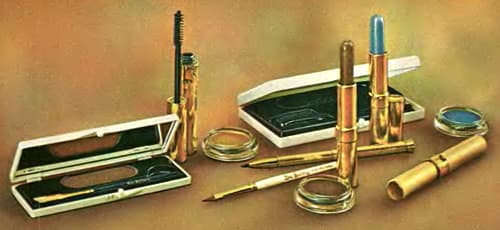
Above: 1964 Du Barry Eye Fashion.
Color Cake Shadow/Liner: “[I]n new brush-and-blend shades. Goes on with moistened brush so you can mix your own special look.”
Brush-On Brow Liner: Shades: Dark Brown, Ash Brown, Charcoal.
Cake Mascara: “[A]ll new professional formula (like the models use) plus big beautiful salon-type brush the illusion of naturally long, devastating lashes.” Shades: Black, Brown, and Midnight.
Brush-On Fluid Mascara: Shades: Black, Brown, and Midnight.
Eyelid Glace: “[D]usts on a shimmer-brush to create the illusion of naturally long devastating lashes.” Shades: Gold, Silver, and Pearl.
Shadow Dusters: “[B]rush-on powdered eye shadow, a dry powder cake of colour applied with slim brush.” Shades: Aqua, Sage Green, Iris, Taupe, Cream, and Pale Amber.
Glissando
In 1964, Du Barry released Glissando lipsticks packaged in a metal, white-ribbed, wedding-ring case, but was available in a cheaper case capped with a white, translucent-plastic lid. The lipsticks had a marbleised look created by partially mixing two or three colours together using a patented system filed in 1963 (U.S. No. 3,201,314: 1965). Perhaps because of this, the shades were given numbers rather than names, a practice Du Barry had used before with its rouges.
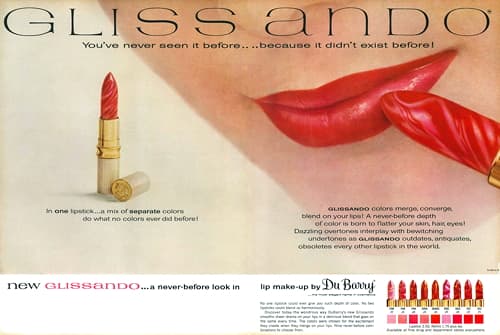
Above: 1964 Du Barry Glissando Lipsticks.
Glissando Lipstick: “Glissando colors merge, converge, blend on your lips! A never-before depth of color is born to flatter your skin, hair, eyes! Dazzling overtones interplay with bewitching undertones. … No one lipstick could give you such depth of color. No two lipsticks could blend so harmoniously.” Shades: Pink #2, Pink #5, Pink #8, Coral #3, Orange #4, Rose #3, Rose #4, Red #2, and Red #5, with Pink #4, Pink #7, Amber #3, Amber #6, Red #6, and Red #7 added later in the year. Three iridescent overglazes in Pearl Glacé, Golden Glacé, and Amber Glacé were added in 1965.
In 1965, Du Barry added Glissando Eye Color Sticks, also marbleised in elongated wedding-ring cases similar to those used for Glissando lipsticks.
Glissando Eye Color Stick: “Fashion surprise for eyes in a subtle blending of shades with swirling, twirling colors that merge to give you a totally new eye shadow toning.” Shades: Blue #1, Blue #3, Blue #5, Turquoise #4, Green #3, Taupe #5, and Lilac #4.
In 1965, Du Barry added Glissando Contouring Make-up compacts that could be used to contour the face. Each compact came with three compressed powders – a basic skin tone with highlighter and shadow – along with a mirror and natural silk sponge applicator. The Contouring Dust-On Compact had two brush-on tints for an over-glow, and Glissando Face Lights could be used for extra highlighting.
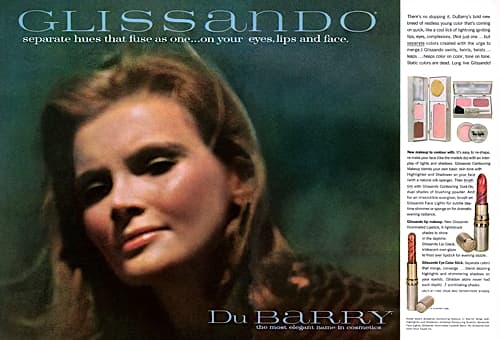
Above: 1965 Du Barry Glissando.
Glissando Contouring Makeup by Du Barry
A revolutionary new color concept separate hues that fuse as one lets you re-shape, re-make,“sculpture” your face with an interplay of light and shadow! Glissando Contouring Makeup blends your own basic skin tone with Highlighter and Shadower. Comes in mirrored kit with natural silk sponge. Glissando Contouring Dust On brush-tints with two shades of blushing powder. And to turn on the glow . . . brush or sponge on Glissando Face Lights. Get all three for truly fabulous effects.(Du Barry advertisement, 1965)
This was not Du Barry’ first use of contouring. TheRichard Hudnut had long subscribed to a face-shaping model along the lines of the one first proposed by Westmores.
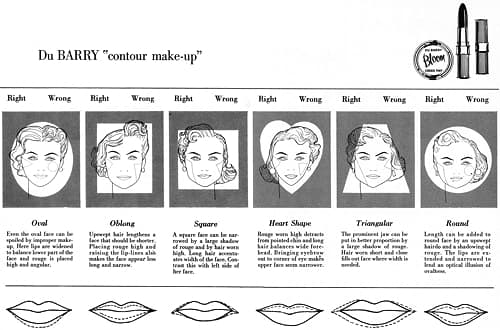
Above: c.1959 Du Barry Contour make-up.
See also: Face Shapes, Corrective Make-up (Contouring), and the company booklet Du Barry Sales Training Manual
In 1966, Du Barry then added Glissando Base Coat and Glissando Nail Enamel to the Glossando lipsticks. The Nail Enamel came in fourteen opaque and iridescent shades matched with Glissando lipsticks, along with Gold and Silver Glitter Overglazes. Du Barry recommended applying two coats of the Nail Enamel but suggested these did not need to be the same shade.
Youth market
Du Barry had made some allowances for teen-agers and younger women before the Second World War. The Du Barry Debutante School was set up to cater for this age group with suggested skin-care treatments for younger skin types.
In 1956, Du Barry introduced its first medicated skin-care range for younger skin types most likely using Bionol (Bithionol) as the germicide. The three products in the range were Medicated Face Wash, Cleansing Grains, and All Clear Medicated Lotion.
New doctor-endorsed treatment works three ways with hypoallergenic formulas to help clear blemishes, blackheads, whiteheads. Medicated Face Wash for “corrective cleansing” combines scientific ingredients, has antiseptic action to combat blemishes, end restores skin’s acid balance. Cleansing Grains “lift” out stub-born blackheads, whiteheads . . . whisks off dry, dead surface cuticle. Wonderful All Clear Medicated Lotion is a unique creamy tinted liquid that instantly covers up imperfections . . . a special formula that heals while if conceals!
(Du Barry advertisement, 1956)
The success of Noxzema’s Cover Girl (1961) was probably the trigger for the development of Du Barry All Clear which combined the three earlier products with some new items all badged as All Clear. Most of the new products were make-up and also contained Bionol as the germicide: All Clear Medicated Make-up and All Clear Medicated Compressed Powder, both in four shades, with All Clear Medicated Lipstick added the following year.
All Clear Medicated Make-up: “In fashion’s new Matte finish, vanishes blemishes out of sight instantly. Containing DuBarry’s own medication, Bionol™, it helps heal as it conceals.”
All Clear Medicated Compressed Powder: “[F]or medicated touch-ups throughout the day. every fluff of flattery helps protect your skin from bacteria.”
All Clear Medicated Face Wash: “Its 2-way action removes soil and make-up, checks bacterial with Bionol.”
All Clear Medicated Astringent: “[C]ontrols skin-oil problems, tighten pores. Use under cleansing, before make-up.”
All Clear Cleansing Grains: “[G]ently whisks away coarsened top skin and blackheads.”
All Clear Medicated Lipstick: “[A] beauty treatment in itself; it conditions as it colors. Du Barry recreates the colors of autumn with 5 new fall fashion shades all of which fit neatly into your purse in silver and gold-tone jewelers cases.” Shades: All Clear Orange, All Clear Pink, All Clear Coral, All Clear Orange Creme, and All Clear Rose Creme.
See also: Cover Girl and the company booklet The Clear Future of a Young Complexion (1959)
In 1969, Du Barry further extended its make-up range for younger women with the Playthings range of transparent gels and translucent liquid and powder make-up. The make-up was packed in colourful plastic containers. Some had a transparent plastic colour chip attached to them in the shade of the enclosed make-up that could be held up to the face to see if the colour was suitable. Products in the range included: Face Tint Gel, Cheek Tint Gel, Translucent Fluid Make-up, Translucent Lipstick, Translucent Face Powder, Brush-On Blusher, Brush-On Brown Eye Shadow Gel, Lower Lid Liner, Liquid Eye Liner, Eye Liner Brush, Lash Lengthener, Brush-On Powdered Eye Shadow.
Men’s lines
As mentioned earlier William Warner had bought the Courtley range of men’s colognes, shaving soaps, face lotions and talcs in 1946, but then sold it in 1955 after it acquired a second men’s line, Sportsman, after Warner-Hudnut merged with Lambert Pharmacal.
In 1964, Warner-Lambert bought the West Indies Bay Company, St. based in Thomas, Virgin Islands that had a range of men’s toiletries sold under the St. Johns trademark. The products continued to be imported from the Virgin Islands after the sale and were sold by Warner-Lambert as a prestige brand.
In 1970, Warner-Lambert made a more significant purchase when it acquired the wet-shave business of Eversharp-Schick.
Overseas operations
A number of the Du Barry cosmetics were replicated overseas in the Three Flowers, Richard Hudnut, Gemey and Chen Yu brands. For example, Du Barry Sophisti-Creme was a Chen Yu cosmetic in France but a Richard Hudnut product in the United Kingdom.
Some replications required lateral thinking. The American Du Barry Paradox line, consisting of Paradox Skin Cream, Creme Cleanser and Moisturising Lotion, was said to contain N.O.R. (Natural Oil Replacement). N.O.R. was also added to the French Gemey line in the form of Gemey Créme de Jour, Créme de Nuit, and Démaquillant N.O.R. However as N.O.R. (Natural Oil Replacement) did not work in the French language it was advertised there as meaning Nourrit, Oxygène and Régénère.
Remnants
Warner-Lambert tried to resurrect the Du Barry line in the 1960s by streamlining its products and introducing new make-up and skin-care ranges but after Warner-Lambert merged with Parke, Davis & Company in 1970, it became clear that maintaining the line would require more money that the company was prepared to spend and a decision seems to have been made to allow Du Barry to die if a buyer for it could not be found (Drugs & Cosmetic Industry, 1974). The same logic appears to have applied to its overseas cosmetics brands and through the 1970s Warner-Lambert gradually disposed of its remaining cosmetics lines.
Three Flowers had been closed down in Britain in the 1950s with other places, such as Australia, ceasing production in the early 1960s. Hudnut tried to revive the brand in the United States in the 1960s and a small remnant of it still exists in the form of Tres Flores, a small men’s line consisting of a liquid and solid brilliantine and an after-shave, sold primarily to Hispanic communities in the Americas by American International Industries, Inc.
Gemey was sold to L’Oreal in 1973 which then combined it with Ricils (1976), Diparco (1977) and Maybelline (1998). The brand still exists in Europe sold as Gemey-Maybelline.
Allercreme and Du Barry was sold to Alcon Laboratories, Inc., a subsidiary of Nestlé S.A. in 1979 when it bought Texas Pharmacal. After it acquired Texas Pharmacal, Alcon changed its name to Dermatological Products of Texas and then sold Du Barry to Carme Cosmeceutical Sciences, Inc. in 1989. Carme was bought by Senetek P.L.C. in 1995 and they licensed Du Barry to the United States International Trading Corporation (U.S.I.T.C.) in 1997 who restarted the line as DuBarry in 2002.
Chen Yu had been managed in Europe through Laboratoires Substantia S.A., a company Warner had established licensing agreements with in 1932. At some stage the European rights were sold and the brand is currently owned by Eugene Perma España S.A. based in Barcelona, Spain and is still in production.
Timeline
| 1946 | Courtley, Inc. bought. |
| 1947 | New Products: Du Barry Sophisti-Cake. |
| 1948 | Chen Yu, Inc. purchased. Du Barry Line repackage. New Products: Richard Hudnut Home Permanent Wave. |
| 1949 | Chen Yu bottle restyled. Du Barry line repackaged. New Products: Du Barry Sophisti-Cream. |
| 1950 | Warner-Hudnut, Inc. formed. New West Coast headquarters opened at 2340 Eastern Avenue, Los Angeles. New Products: Du Barry Cream Superbe; and Richard Hudnut Formula A-10; and Chen Yu Fluid Cloud Silk. |
| 1951 | Warner-Hudnut stock sold. New Products: Richard Hudnut Tru-Tint home hair color. |
| 1952 | Chilcott Laboratories Ltd. acquired. New Products: Du Barry Flatter Face. |
| 1953 | New Products: Du Barry Penetrating Balm; Du Barry Flatter-Glo; Richard Hudnut Drystick; and Richard Hudnut Spray and Stay. |
| 1954 | Pfeiffer family sells Warner-Hudnut stock to American Drug Products Ltd. New Products: Du Barry Liquid Treasure; Du Barry Bloom cream rouge; and Richard Hudnut Pink Suds. |
| 1955 | Warner-Hudnut merges with Lambert Pharmacal to form Warner-Lambert Pharmaceutical. Warner-Lambert opens branches in The Philipines, Venezuela, and Central America. Warner-Lambert sells the Courtley line to Lee Ltd. Hudnut Du Barry salon at 693 Fifth Avenue closed. New Products: Du Barry Royal Treatment Cream; and Du Barry Liquid Bloom. |
| 1956 | New showroom opens on the corner of Fifth Avenue and 60th Street, New York. Hudnut manufacturing and offices moved to Lititz, Pennsylvania. New British manufacturing laboratory opened in Chesnut Avenue, Eastleigh, Hants. New Products: Du Barry Lotion Superbe; Du Barry Young Promise, Richard Hudnut Bliss; and Richard Hudnut Beauty Curl. |
| 1957 | New Products: Du Barry Vibrance Creme Masque; Du Barry Royal Nectar; and Du Barry Creme Mascara. |
| 1958 | New Products: Du Barry Royal Balm, Du Barry Royal Eye Crème; Du Barry Royal Velvet Fluid Make-up; Du Barry Royal Lipstick; Du Barry Royal Shampoo; Du Barry Royal Creme Rinse; Du Barry Royal Hair Conditioner; Du Barry Elixir Natale; Du Barry Creme Natale; Du Barry Moisture Petals; Du Barry Cloudsilk Pearled Face Powder; and Du Barry Penetrating Cleanser. |
| 1959 | New Products: Richard Hudnut Lip Quick; and Du Barry Flatter Fluff. |
| 1960 | New Products: Du Barry Crème Paradox, and Du Barry Dory Beauty Masque. |
| 1961 | Warner-Lambert creates a Du Barry Division and a Richard Hudnut Division to improve sales. |
| 1962 | William Warner & Co. Ltd. of England buys The Dubarry Perfumery Company, Hove. New Products: Du Barry Flatter Magic. |
| 1963 | New Products: Du Barry Paradox Creme Cleanser; and Du Barry Paradox Moisturizing Lotion. |
| 1964 | West Indies Bay Company purchased. New Products: Du Barry Glissando Lipstick. |
| 1965 | New Products: Du Barry Paradox Milk Bath; Du Barry Paradox Body Crème; Du Barry Paradox After-Bath Dusting Powder; and Du Barry Glissando Eye Color Sticks. |
| 1966 | Texas Pharmacal acquired. New Products: Du Barry Glissando Nail Enamel; Du Barry Bloom Dust-On; and Du Barry Illuminated Bloom Dust-On. |
| 1967 | New Products: Du Barry Shadow Dusters; and Du Barry Pearl Glace Lip Lilies. |
| 1969 | Wet-shave business of Eversharp-Schick acquired. New Products: Du Barry Lasting Beauty Makeup Finish. |
| 1973 | Gemey sold to L’Oreal. |
| 1974 | Du Barry merged into Texas Pharmacal. |
| 1979 | Texas Pharmacal (Allercreme and DuBarry) sold to Alcon Laboratories, Inc. |
| 1993 | Wilkinson Sword bought. |
| 2000 | Warner-Lambert acquired by Pfizer, Inc. |
First Posted: 9th March 2015
Last Update: 8th February 2024
Sources
Abrams, G. J. (1977). That man. The story of Charles Revson. New York: Manor Books.
The American perfumer & essential oil review. (1906-1955). New York: Robbins Perfumer Co. [etc.].
Corporations: Life begins at 60. (1952). TIME. February 11. Retrieved February 5, 2015, from http://www.time.com/time/
magazine/article/0,9171,815988,00.html
The drug and cosmetic industry. (1932-1997). New York: Harcourt Brace Jovanovich [etc.].
Klein, H. G. (1974). A DCI company profile Warner-Lambert. Drugs & Cosmetics Industry, May, 46-48, 125-128.
Richard Hudnut. (1955). Help yourself to new beauty with Du Barry [Booklet]. New York: Author.
Smith, R. C. (2010). Paper fortunes: Modern Wall Street; where it’s been and where it’s going. New York: St Martin’s Press.
Warner-Lambert Pharmaceutical Company Annual Reports 1955-1980.
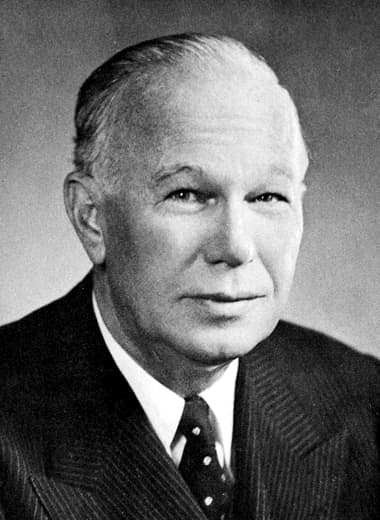
Elmer Holmes Bobst [1884-1978].
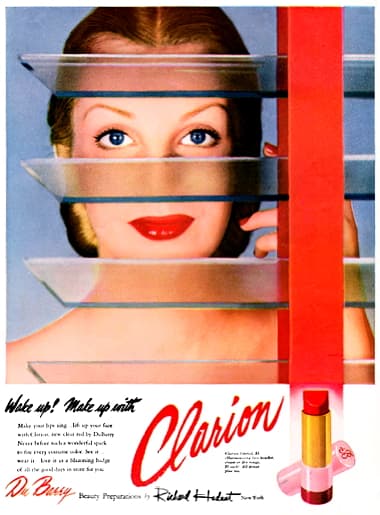
1945 Du Barry Clarion in a plastic and metal case.
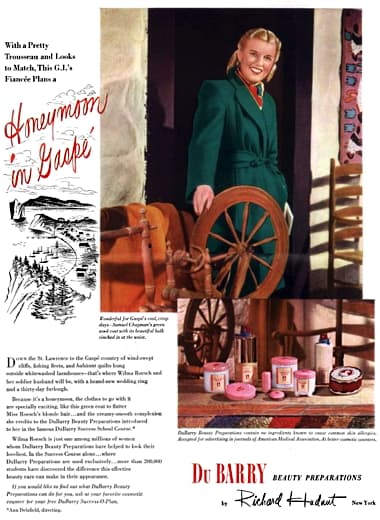
1945 Du Barry Beauty Preparations.
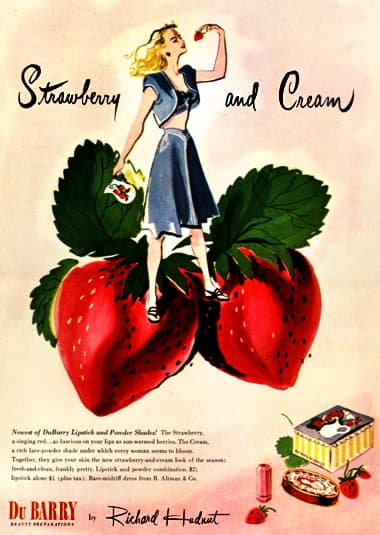
1945 Du Barry Strawberry (Lipstick) and Cream (Face Powder).
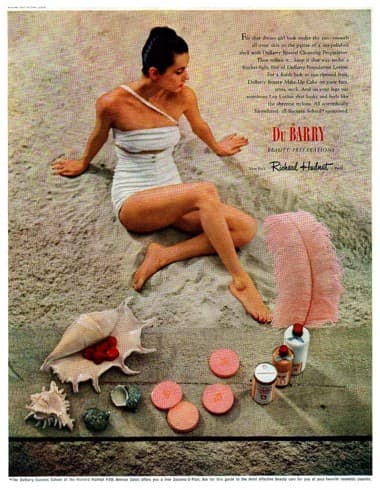
1945 Du Barry Beauty Preparations.
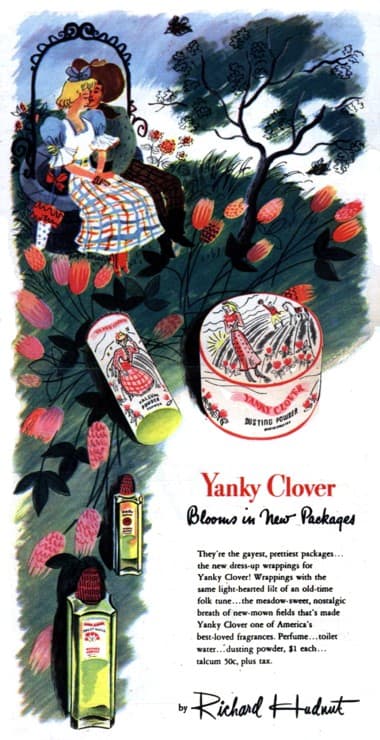
1945 Yanky Clover. Although the perfume originates from 1898, the Yanky Clover line was only developed just before the Second World War.
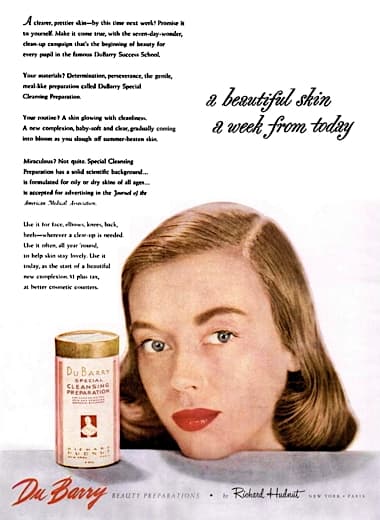
1946 Du Barry Special Cleansing Cream.
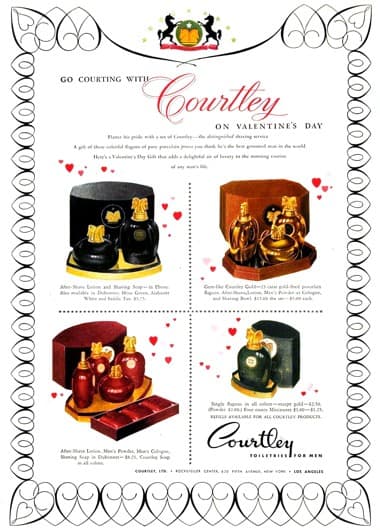
1947 Courtley Toiletries for Men. The line was bought in 1946 but sold to Lee Ltd. in 1955.
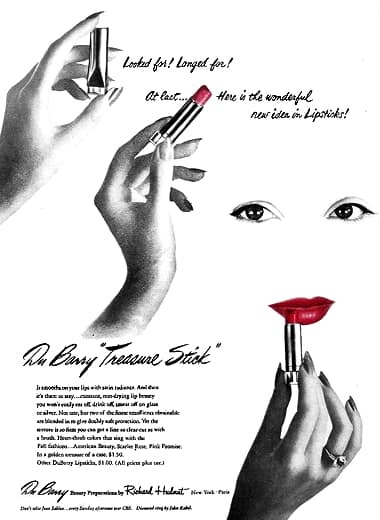
1947 Du Barry Treasure Stick.
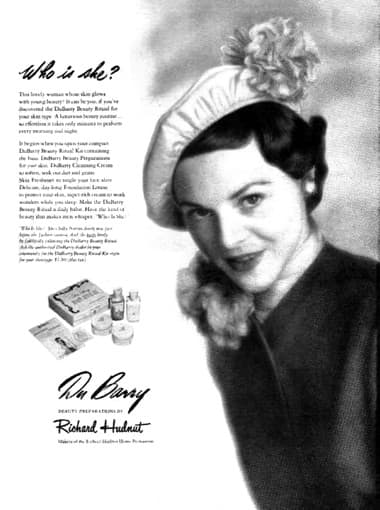
1949 Du Barry Home Permanant Kit.
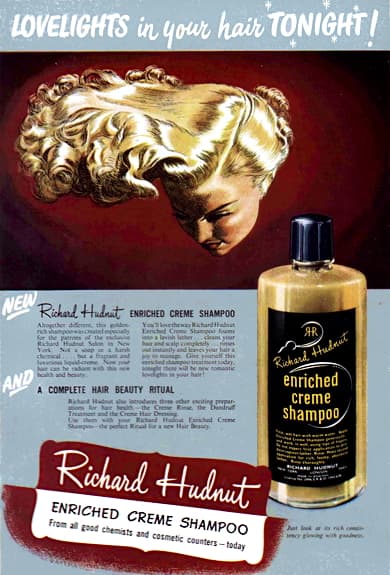
1949 Richard Hudnut Enriched Creme Shampoo (Britain).
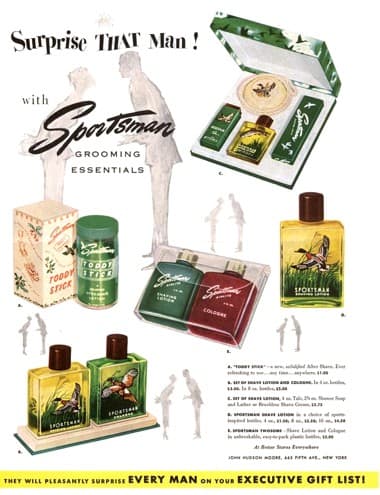
1950 Sportsman Men’s Toiletries. This line was acquired through the purchase of Lambert Pharmacal in 1955.
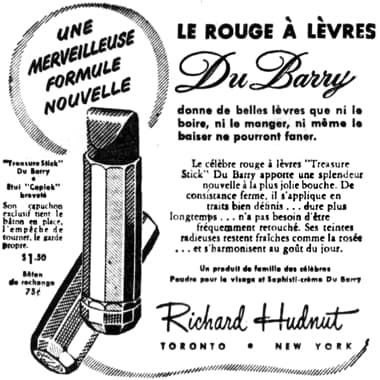
1951 Richard Hudnut Treasure Stick Lipstick in a caplok case (France).
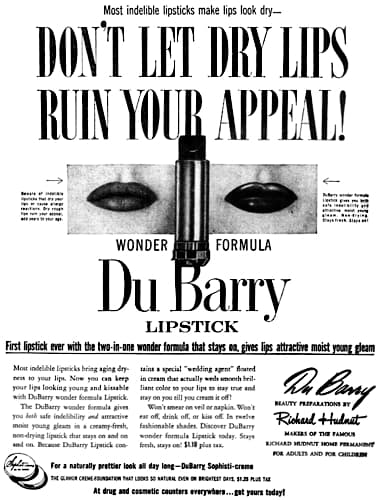
1952 Du Barry Lipstick in a caplok case.
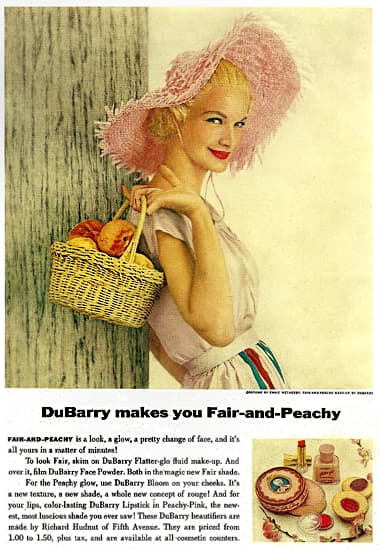
1954 Du Barry Fair (Flatter-Glo Fluid Make-up) and Peachy (Peachy-Pink Lipstick).
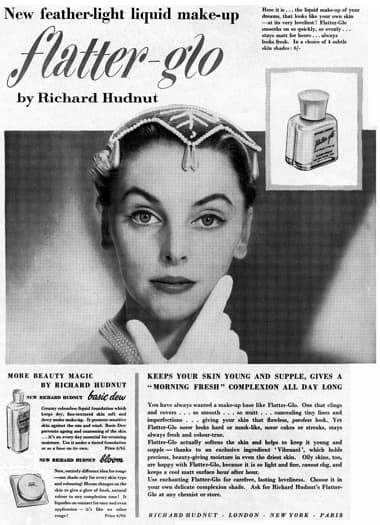
1955 Flatter-Glo sold in Britain through the Richard Hudnut range. Another product mentioned in this advertisement, Basic Dew, was particular to Britain.
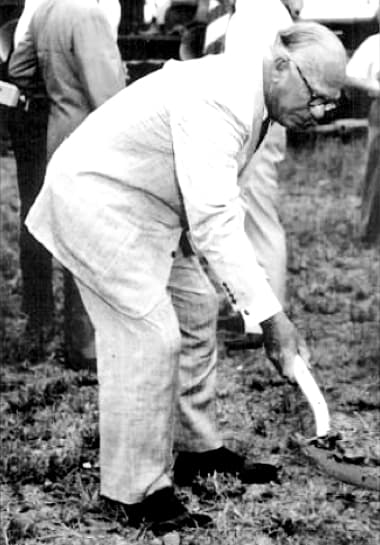
1955 Elmer H. Bobst breaking ground at the new Warner-Lambert plant in Lititz, Pennsylvania. Bobst was born in Lititz and grew up there.
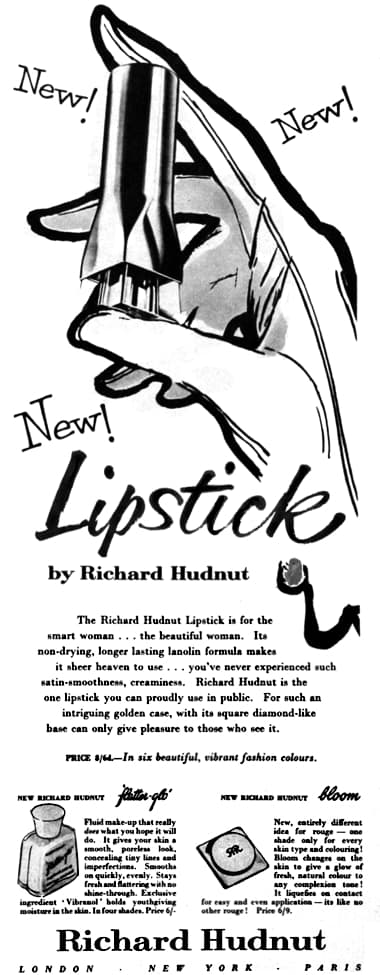
1955 Richard Hudnut Lipstick in a lucite-based case, Flatter-Glo liquid make-up and Bloom rouge (Britain).
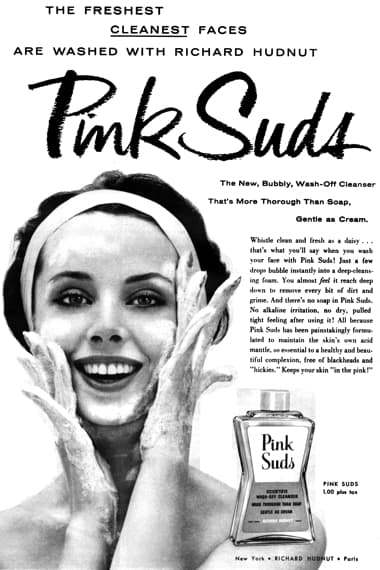
1955 Richard Hudnut Pink Suds.
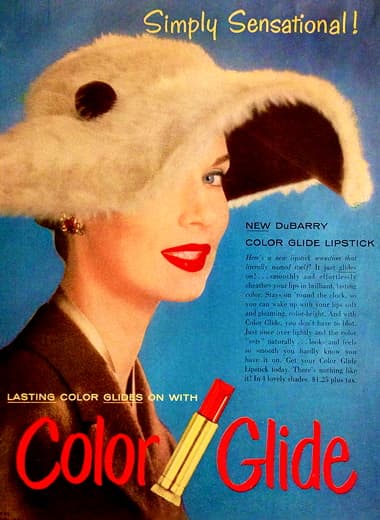
1955 Du Barry Color Glide Lisptick.
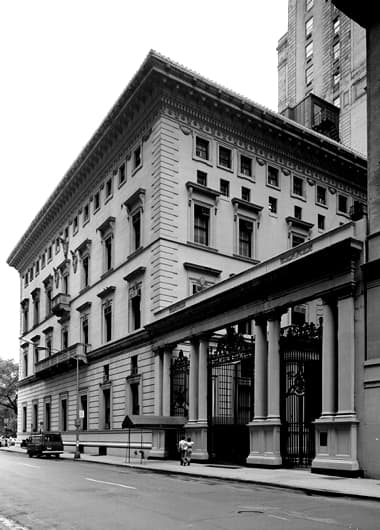
The Metropolitan Club on the corner of Fifth Avenue and 60th Street, New York. A new showroom was opened here in 1956.
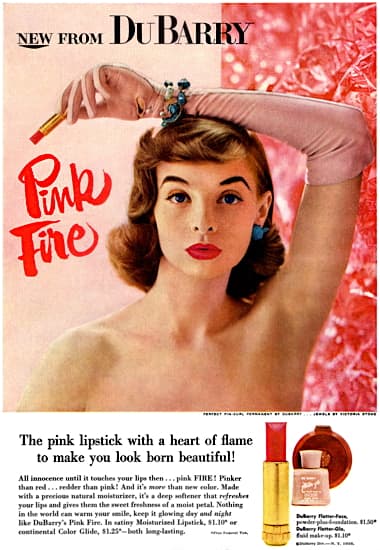
1956 Du Barry Pink Fire in a caplok case.
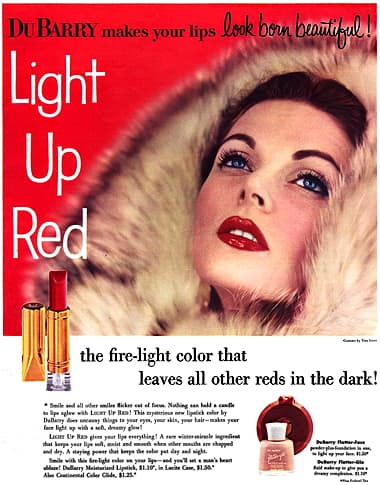
1956 Du Barry Light Up Red in a lucite-base case.
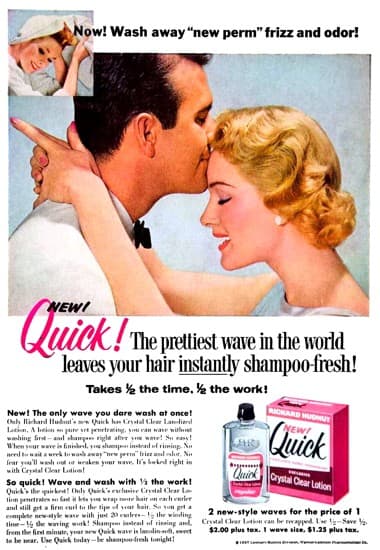
1957 Richard Hudnut Quick Lanolized Home Permanent.
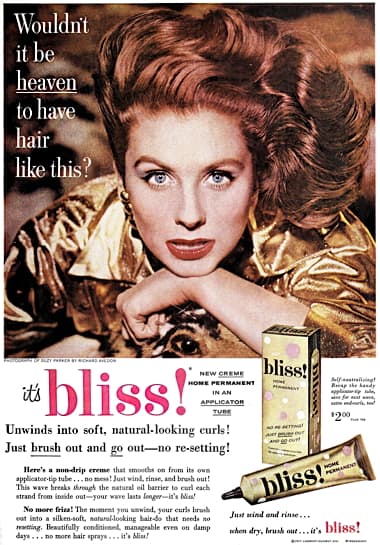
1957 Richard Hudnut Bliss.
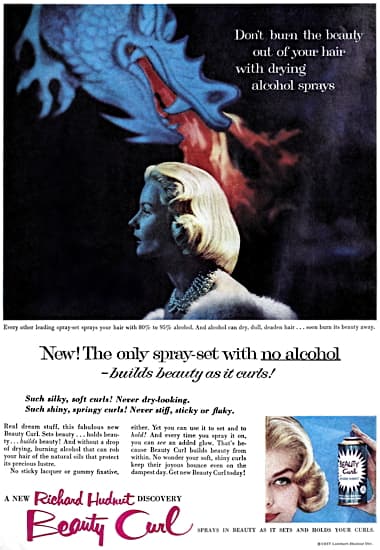
1957 Richard Hudnut Beauty Curl.
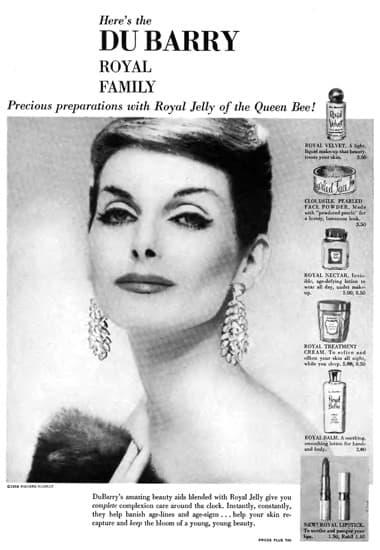
1958 Du Barry Royal Treatment line.
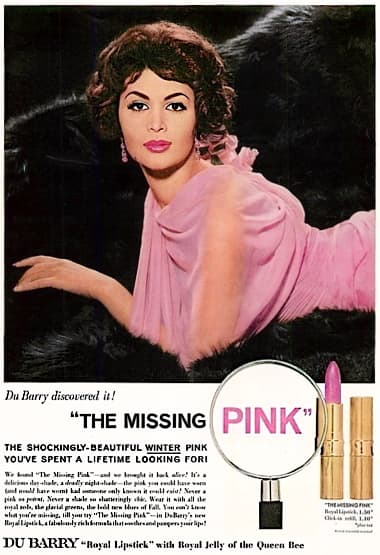
1958 Du Barry The Missing Pink Royal Lipstick in a ‘wedding ring’ case.
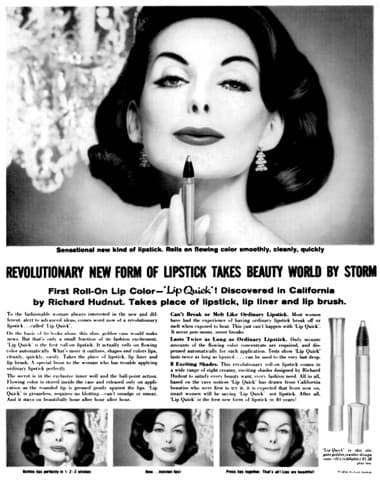
1959 Richard Hudnut Lip Quick Lipstick. In Australia the product was sold as the Gemey Lip Matic.
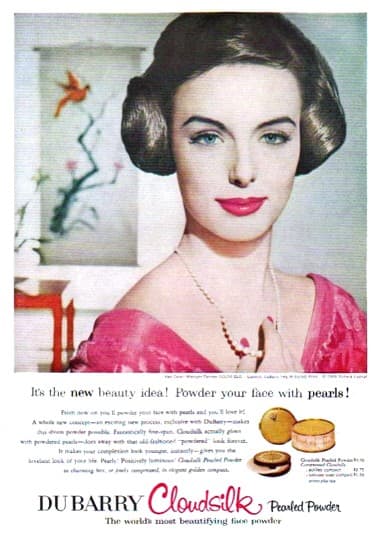
1959 Du Barry Cloudsilk Pearled Powder.
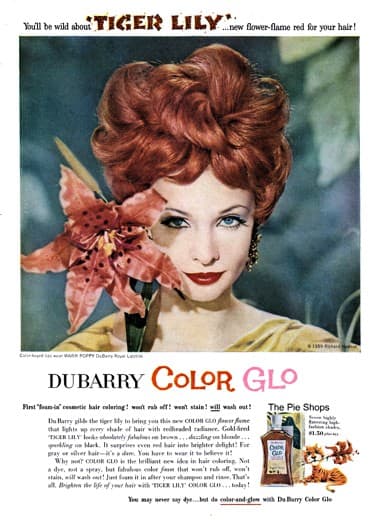
1959 Du Barry Color Glo hair colouring.
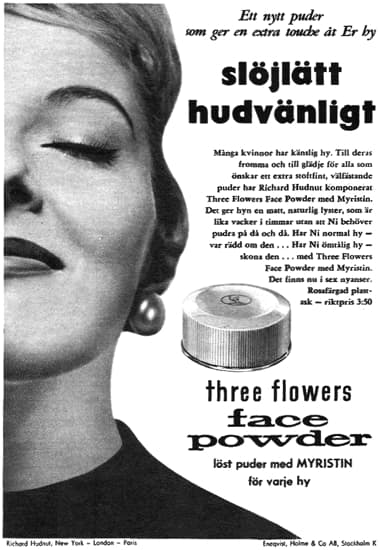
1959 Three Flowers (Sweden).
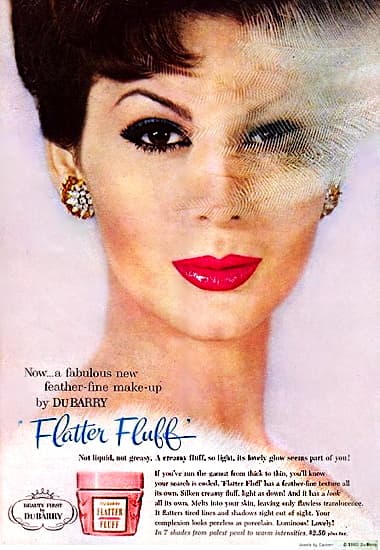
1960 Du Barry Flatter Fluff.
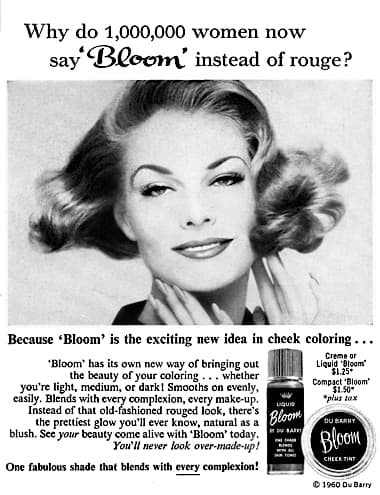
1960 Du Barry Bloom (Liquid and Cream)
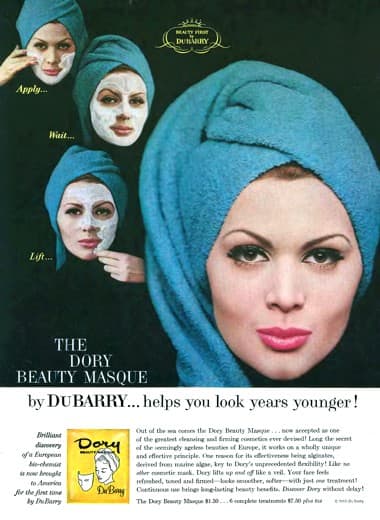
1960 Du Barry Dory Beauty Masque.
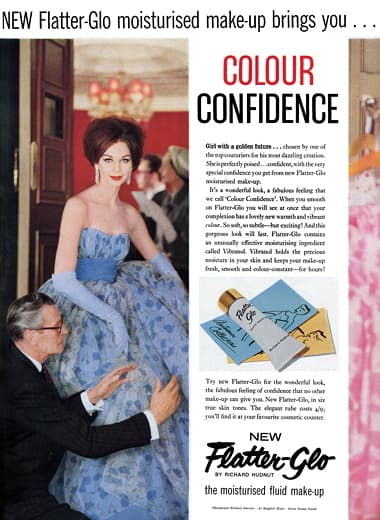
1960 Du Barry Flatter-Glo.
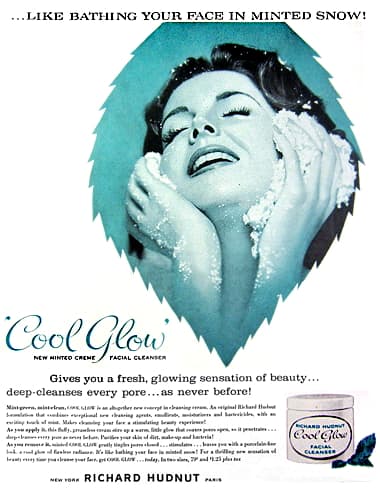
1960 Richard Hudnut Cool Glow.
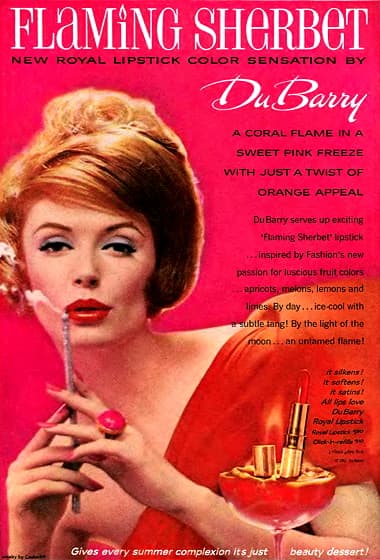
1961 Du Barry Flaming Shebert.
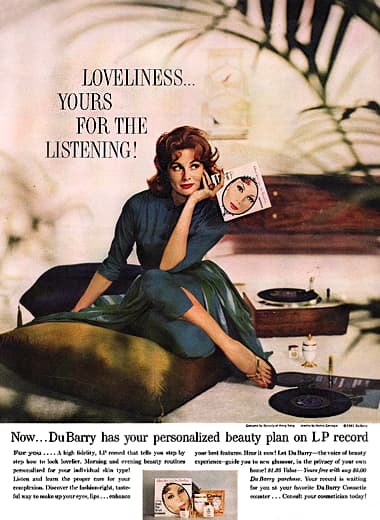
1961 Du Barry Beauty Plan. There were three records in the series for normal-to-dry skins, normal-to-oily skins, and teen-age or troubled skins.
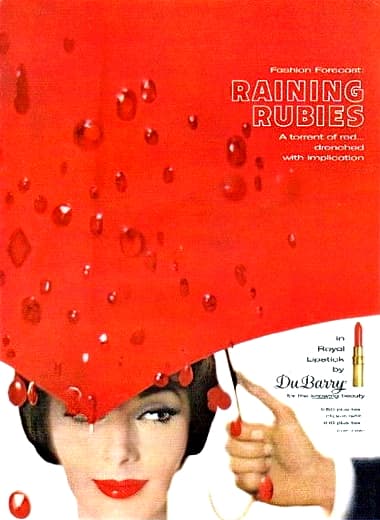
1962 Du Barry Royal Lipstick Raining Rubies.
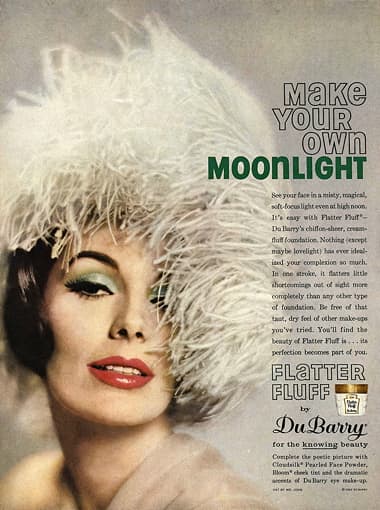
1962 Du Barry Flatter Fluff.
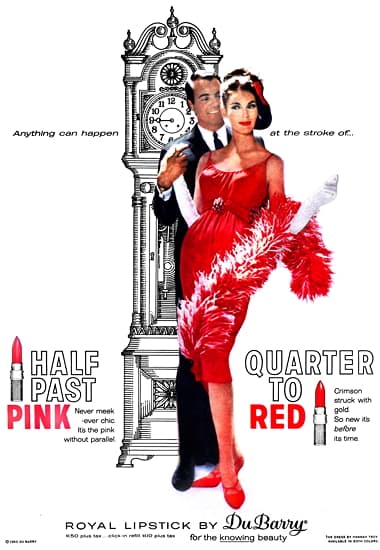
1962 Du Barry Half Past Pink, and Quarter to Red.
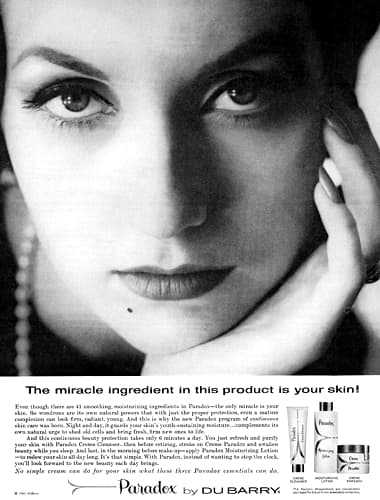
1963 Du Barry Paradox Creme Cleanser, Paradox Moisturizing Lotion, and Creme Paradox.
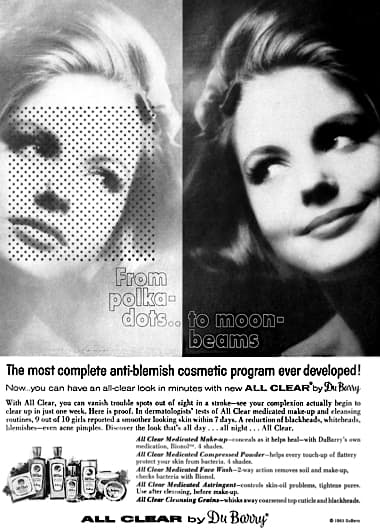
1963 Du Barry All Clear.
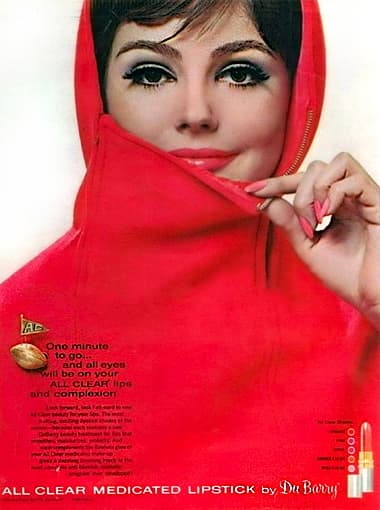
1963 Du Barry All Clear Medicated Lipstick.
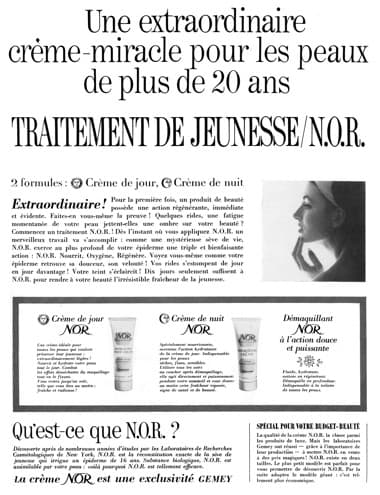
1963 Gemey Traitement de Jeunesse/N.O.R (France), the Gemey equivalent of the Du Barry Paradox line.
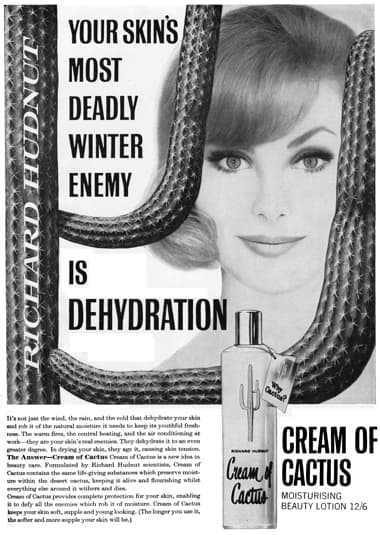
1963 Richard Hudnut Cream of Cactus moisturiser (Britain) sold in a white squeeze bottle. Introduced in 1962, it contained an extract from the giant desert cactus that helped the cactus survive drought. As far as I can tell it was not available in the United States.
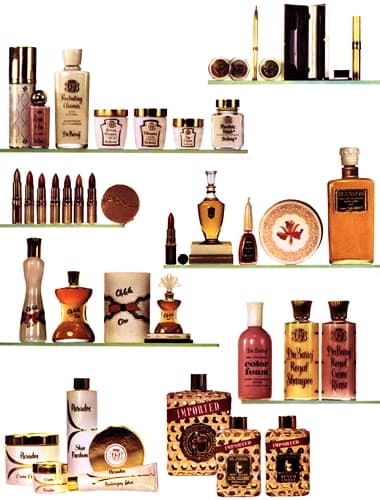
1964 Warner-Lambert cosmetics and toiletries.
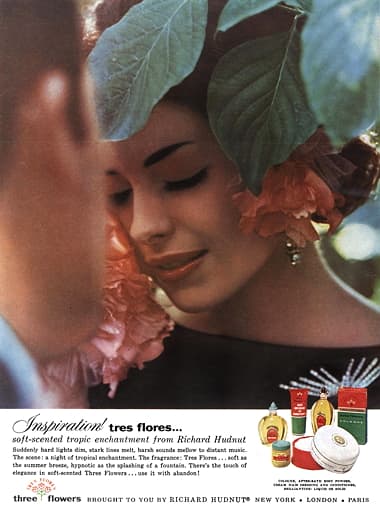
1964 Richard Hudnut Three Flowers Cologne, After-Bath Body Powder, Cream Hair Dressing and Conditioner, and Brilliantine (liquid or solid).
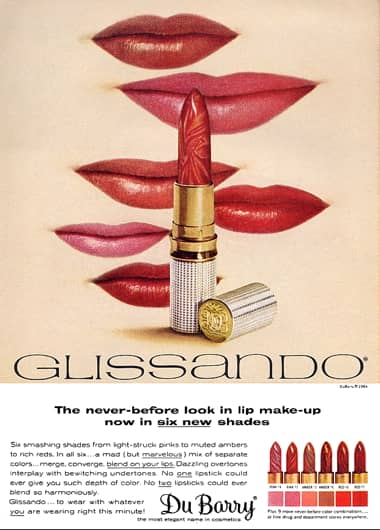
1964 Du Barry Glissando Lipstick.
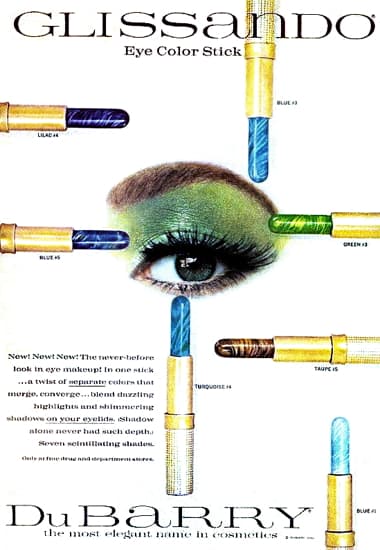
1965 Du Barry Glissando Eye Color Stick.
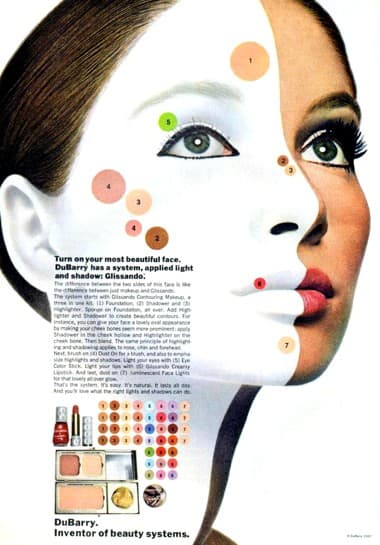
1967 Du Barry Glissando System.
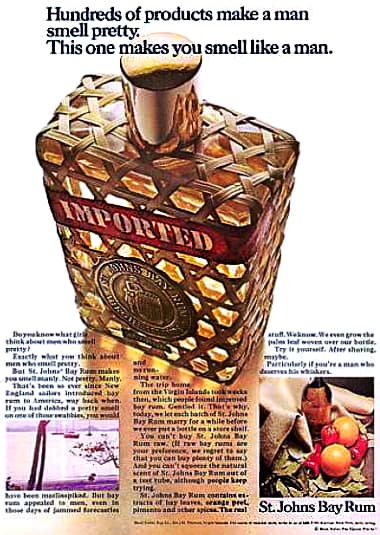
1967 St Johns Bay Rum Aftershave.
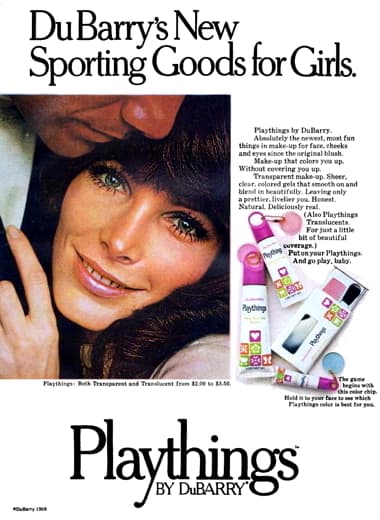
1969 Du Barry Playthings.
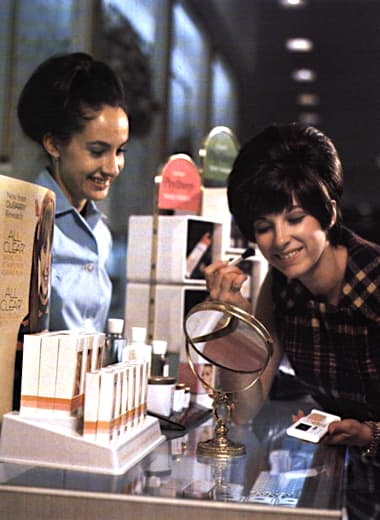
1969 Du Barry make-up counter with a woman is trying on Playthings make-up. The packages in the front of the counter are for All Clear.
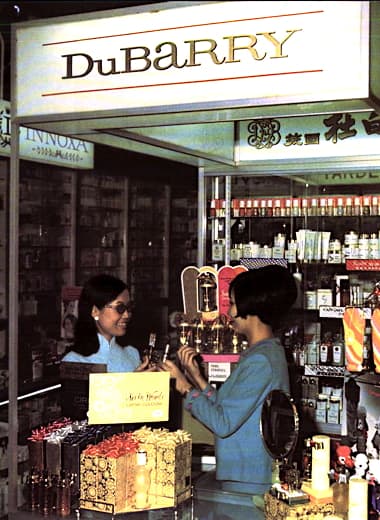
1969 Du Barry Hong Kong. Warner-Lambert entered the Hong-Kong market in 1967. It could do so with Du Barry as it had bought the British DuBarry Perfumery Company in 1963.
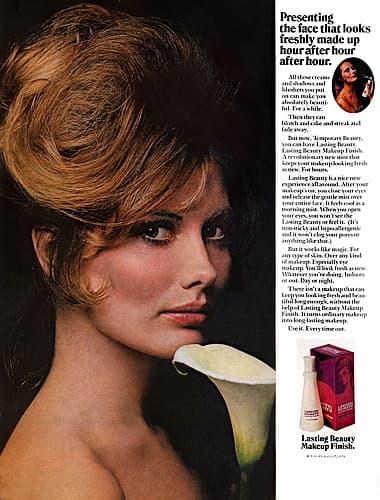
1970 Du Barry Lasting Beauty Make-up Finish.
